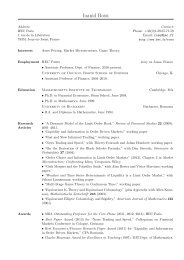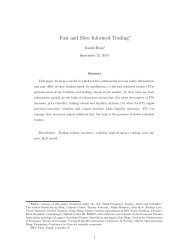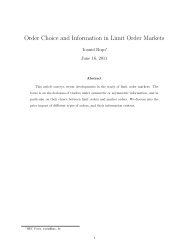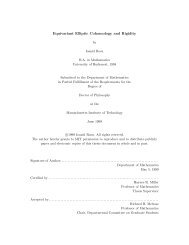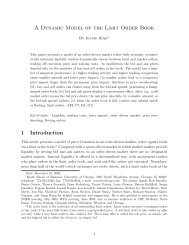HEC Paris Professor Ioanid Rosu MBA Financial Markets Fall 2012 ...
HEC Paris Professor Ioanid Rosu MBA Financial Markets Fall 2012 ...
HEC Paris Professor Ioanid Rosu MBA Financial Markets Fall 2012 ...
You also want an ePaper? Increase the reach of your titles
YUMPU automatically turns print PDFs into web optimized ePapers that Google loves.
<strong>HEC</strong> <strong>Paris</strong><br />
<strong>Professor</strong> <strong>Ioanid</strong> <strong>Rosu</strong><br />
<strong>MBA</strong> <strong>Financial</strong> <strong>Markets</strong><br />
<strong>Fall</strong> <strong>2012</strong><br />
Case/Assignment #3<br />
Bonds; Forwards and Futures<br />
The assignment should be typed (or written legibly) and is The assignment should be<br />
typed (or written legibly) and is due at the beginning of class on November 26/27/28<br />
(Week 9). No late assignments will be accepted. You may discuss the assignment only<br />
with members of your group. Please, hand in one solution per group. When printing your<br />
assignment, include only the relevant tables and numbers, not all the Excel data you are<br />
using.<br />
Problem 1. You are in charge of the bond trading department of a large investment bank.<br />
The yield curve for years 1, 2 and 3 is displayed on your computer terminal as follows:<br />
Maturity 1 2 3<br />
YTM 5% 7% 6%<br />
A new summer intern from <strong>HEC</strong> has just observed that the 3-year Treasury note with face<br />
value $1000 and annual coupon rate 8% trades at $1023.00.<br />
(a) Is the price of the bond consistent with the given list of yields?<br />
(b) If the price of the coupon bond is not consistent with the given list of yields, what would<br />
you do to in order to take advantage of this situation? Be explicit in describing your<br />
strategy. You are allowed to invest in the given coupon bond, and in 1-year, 2-year, and<br />
3-year strips.<br />
Problem 2. Suppose it is February 22, 2006 and you have the following data for the S&P<br />
500 and the FTSE 100. Since the index futures expire on the 3rd Friday of the month, there<br />
are approximately 4 months until the expiration of the June contract, and 7 months until the<br />
expiration of the September contract. Fill in the missing numbers in this table of stock index<br />
futures prices.<br />
Country Index Index Dividend Spot interest Futures Futures Price<br />
Name Value Yield rate Term (same unit as<br />
(annualized) (annualized) (months) index value)<br />
US S&P 500 1292.67 1.70% 4.68 % 4 ???<br />
UK FTSE 100 5872.40 ??? 4.29 % 7 5850.5<br />
1
Case 1. You are analyzing Treasury bond data on August 9, 2010. You have the following<br />
table of yields to maturity<br />
(a) From the Wall Street Journal you get also the following information about the 3-year<br />
Treasury note:<br />
Ask<br />
Date Maturity Coupon Bid Ask Yield<br />
2010 Aug 09 2013 Aug 15 4.250 110:11 110:13 0.7539<br />
Note here that the face value of the bond is considered to be F = 100, and the coupon<br />
rate is 4.250%. The bid and ask prices are quoted in 32-nds, which means for example<br />
that P ask = 110:13 = 110 + 13<br />
32 = 110.4063.<br />
For now, let’s assume that the coupon is paid annually. Are then these quoted prices<br />
consistent with the given list of yields to maturity on August 9? By being consistent<br />
here I mean whether the fair price of the bond given the yield curve is between the<br />
quoted bid and ask prices.<br />
(b) August 9, 2010 is in fact a little more than 3 years away from August 15, 2013 (it is<br />
3.0164 years away). If you write the present value formula for the bond using the exact<br />
time until cash flows occur, does that change the price significantly? (Again, we assume<br />
that the bond pays annual coupons.)<br />
(c) In reality, coupons are paid semi-annually. Every 6 months, the owner of the bond gets<br />
4.250%<br />
half the coupon: = 2.125% of face value. How does that change the fair price of<br />
2<br />
the 3-year Treasury note? For simplicity, assume that the coupons are paid after 0.5, 1,<br />
1.5, 2, 2.5, and 3 years. (That is, forget about the extra 6 days from Aug 9 to Aug 15.)<br />
Hint: The yield to maturity, e.g., for 2.5 years cannot be found in the table, but you<br />
can take YTM 2.5 = YTM 2+YTM 3<br />
= 0.54%+0.81% = 0.675%.<br />
2 2<br />
2
(d) By just looking at the shape of the U.S. Treasury yield curve on August 9, 2010 below,<br />
which of the four types of yield curve is it?<br />
(e) Normally, what type of economy does such a shape of the yield curve predict? Do you<br />
think it should work in this particular case? Why or why not? (Hint: Consider both<br />
the short end and the long end of the curve in your analysis.)<br />
3



